Text
Public Transit Agencies Think Rewards Programs Can Bring Back Riders
Four decades after American Airlines invented the frequent flier, loyalty programs have started to spread beyond airlines and into urban travel. Last November, Uber launched Uber Rewards, using perks like vehicle upgrades to woo and keep fickle customers. Uber’s program design nudges riders to take individual instead of shared trips, sparking worries that whatever impact ride-hail has on urban congestion, Uber Rewards will make it worse.
Now, though, some public transportation agencies—which take cars off the road and may, in certain cities, be losing fares to ride-hail—are responding in kind. Capitalizing on the spread of smartphones and mobile ticketing systems, which make personalized rewards much easier to administer, transit officials around the country are preparing for your daily commute to score you complimentary drinks, gift certificates, even free rides.
One of the first transit agencies to use rewards to tweak customer behavior was Bay Area Rapid Transit, which serves San Francisco and its environs. In 2016 it launched a pilot program called BART Perks, offering small cash rewards to commuters who opted to travel at less congested, off-peak times. BART claimed it got around 10 percent of targeted riders to make the adjustment. It ran a second, similar experiment earlier this year, funded by a $500,000 federal grant, with results expected in August.
On the east side of the San Francisco Bay, Contra Costa Transportation Authority took the idea a step further by trying to entice commuters to switch their mode of transport entirely. In November it launched a pilot with a startup called Miles, whose smartphone app tracks a customer’s location and uses machine learning to determine how they’re moving. The program awards “miles” based on distance and the mode of transport. Walking one mile is good for 10 “miles.” Driving the same distance nets you just one, with biking, transit, and ride-hail falling in between. The miles can be redeemed on the app for rewards through its partners (from whom Miles earns commissions).
The agency gave Miles $50,000 to create “challenges” that offer select Contra Costa County residents a $5 gift card to retailers like Starbucks or Amazon if they adjust their commuting habits to drive less often. “If you’re using a bike twice per week and driving three days a week, we want you to bike more,” says Peter Engel, the agency’s director of programs. CCTA is currently reviewing data from the pilot. In the meantime, its Bay Area compatriot Caltrain and nearby Sacramento Regional Transit have announced their own projects with Miles, with the same goal of pushing commuters away from driving.
Portland, Oregon’s bike-share system has taken a different approach. Biketown has been working with a startup called Validated to offer credits—which can be used to cover overage fees or annual memberships—to users who make purchases at retailers like Portland Gear and Green Zebra Grocery. In May, Validated was acquired for an undisclosed sum by ReachNow, a company that builds mobile ticketing systems for transit agencies. Its North American CEO, Nat Parker, believes that Validated’s model could work for transit, especially as cities like Baltimore and New York adopt mobile ticketing. “Discovery of offers, redemption of points, and interaction with the customer are all much easier to facilitate through a mobile channel,” he says.
Transit officials nationwide are getting excited about loyalty programs’ potential. J. C. Vannatta leads marketing and communications at Portland’s TriMet, where his agency is exploring a new rewards system. “We see the value of what it could bring, not only keeping our own riders coming back but also attracting new ones.” In Philadelphia, Septa marketing chief Liz Bradford says her agency could capitalize on its new mobile ticketing system to offer riders rewards based on their physical location. “If you arrive at Haverford Septa station and we have a partner nearby, we could send a push notification offering $1 off a beer tonight.” Such partnerships could give cash-starved transit agencies a valuable new revenue source.
It’s likely best, however, not to get too excited about this new tool. David Bragdon, the executive director of public transportation research organization TransitCenter, thinks the hullaballoo around loyalty programs risks distracting agencies from more urgent priorities. “The best loyalty program is to provide good service,” he says. “Fundamentals of good service are frequency, speed, and reliability. If you don’t have that, giving someone a free cup of coffee doesn’t make any difference.”
Perhaps not, but transit executives are eager to reverse the ridership declines that many of their systems face. Loyalty programs offer them a potential new tool to attract riders, and a chance to keep pace with the ride-hail companies that are often accused of poaching their customer base. As competition for urban trips intensifies, they seem willing to try just about anything to keep filling the fare box.
Original Article : HERE ; This post was curated & posted using : RealSpecific
Public Transit Agencies Think Rewards Programs Can Bring Back Riders was originally posted by Advice4all News
0 notes
Text
Asian women and the kimono have long been sexualized in western culture
Its no surprise that Kim Kardashian West appropriated kimono to give sex appeal to her shapewear line, writes Akemi Johnson

The two Asian women painted on the facade of the Irish pub outside the US military base in Okinawa, Japan, wore kimono. They lounged on a white-sand beach. Their black hair was coiled atop their heads, and their garments were falling open to reveal bare legs and cleavage.
Never mind that the real women in that area didnt dress like that. Instead of kimono and up-dos they sported colored contacts, blonde hair extensions, fake tans and jeans. Never mind that kimono are ankle-length and high-necked, covered-up. To the artist or bar owner, the picture that would draw men inside, the epitome of desire, was the woman in the kimono and an erotic style of kimono that doesnt exist.
Its no surprise that Kim Kardashian West appropriated kimono to sell underwear. In the western imagination, Asian women have long been sexualized, and an emblem of the Asian woman is the iconic Japanese gown.
When American troops invaded Okinawa in April 1945, the specter of the sexualized Asian woman already existed. The pigs and chickens are okay, one marine told a Chicago Daily Tribune reporter, shortly after the American landing, but Im disappointed in the girls. Theyre not what they told me. Implying a surprised disgust, the reporter goes on to describe local women bathing and washing their clothes in a roadside trough.
These were women caught between opposing forces on a battlefield, tasked with fighting for their lives amid a typhoon of steel. And yet these American invaders saw them only in sexual terms, evaluated alongside livestock.
This viewpoint continued in the aftermath of the battle, when Okinawan survivors were traumatized and destitute. Hubba! Hubba! reads a caption in a US military souvenir booklet produced just after the war. The photo is of an Okinawan woman dressed in worn clothes and sandals, her baby strapped to her back.
Maybe Kardashian Wests attempt to name her shapewear line Kimono was a marketing stunt with the backlash, how many of us have now seen her nude bodysuits or maybe the word seemed to offer up the exoticism, the sex appeal, she was looking for.
In Japan, the kimono means something very different than in the west. In the country today, kimono are formal wear. Often made of silk and costing upwards of a thousand dollars, a kimono is attire for a wedding, a graduation or other special occasion. It connotes not sex, but tradition and elegance.
Upon hearing this cultural treasure was being used to shill American underwear, Japanese citizens reacted with anger. The mayor of Kyoto weighed in, penning a letter to Kardashian West asking her to reconsider her Kimono trademark. The city, he reported, was undertaking its own efforts to register Kimono Culture to Unescos Intangible Cultural Heritage list. (Kardashian West had reportedly trademarked names like Kimono World.) The kimono, Mayor Daisaku Kadokawa wrote, truly symbolizes [the] sense of beauty, spirits and values of Japanese.
Japanese Americans also joined the #KimOhNo outcry, but for those of us of Japanese heritage in the States, the kimono can have a more complicated symbolism. My own relationship to the style of clothing began as a toddler, when my mother first dressed me up in a mini kimono-like garment. When I was in third grade, my great-grandmother, who had immigrated to the United States from Hiroshima, visited my school to demonstrate the tricky process of putting a kimono on.
Years later, studying abroad in Kyoto in college, my first time to Japan, I tried on an authentic kimono myself, when my classmates and I rented them for a day. It looks better if your geta are too small, the Japanese woman dressing me said. Wearing too-small shoes was just one way the kimono-wearing experience was physically restrictive. In the tight column of fabric, I tottered around the citys historic streets.
To the tourists who snapped photos of me that day, I may have looked like a traditional Japanese woman, a titillating figure straight from the pages of Memoirs of a Geisha. But I knew to the natives of the city even the classic Japanese gown wouldnt cause them to see past my mixed-race face and American ways. Even wearing a kimono, I wasnt truly Japanese.
The Japanese American artist Judy Shintani has a series called Deconstructed Kimonos. Shintani transforms kimono by cutting away patterns in the fabric, reducing them to shreds.
My alterations reflect the loosening connection to my ancestry and culture, she writes, and she evokes the intense pressure Japanese Americans felt to assimilate during the second world war. After Pearl Harbor, her family and many others, including mine, made bonfires out of anything deemed Japanese. Into the flames went Japanese scrolls, books and kimono.
As a symbol of Japanese American culture, Shintanis shredded kimono feels fitting. Ravaged by a life in America, it, as Shintani writes, is reduced to a skeleton, a web yet still retains the outlines of its original form.
This is what America has done to the kimono. Kardashian West may have announced her intention to rename her brand, but the story of the kimono here has already been rewritten.
Still, just the other day, a Japanese American friend gifted me a bright pink, tiny jinbei for my infant daughter. A mixed-race, fifth-generation Japanese American, my daughter will wear the cotton, kimono-like onesie to a summer obon festival. I imagine that, years from now, she can look back at a photo of herself in it and decide what the garment means to her.
Original Article : HERE ; This post was curated & posted using : RealSpecific
Asian women and the kimono have long been sexualized in western culture was originally posted by Advice4all News
0 notes
Text
Trolls and a flag leave sports marketing masters of universe in black hole | Marina Hyde
Botched launches of Arsenals kit and Nikes trainer exposes halfwitted naivety among wizards of merchandising
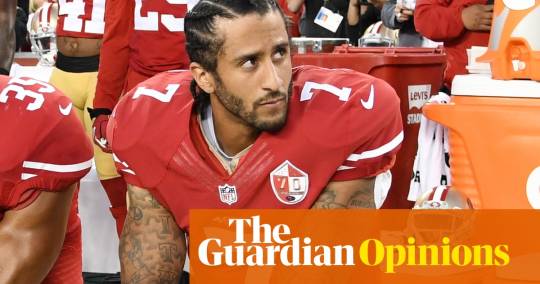
Does any profession attract a higher percentage of sweet summer children than sportswear marketing? We are encouraged to think of this most modern discipline as a sophisticated, perhaps even cutthroat world, where promotional and sales whizzes compete to be the best of the best in the battle to market various symphonies in sweat-wicking polyester and cheap leather.
In which case, why does the appearance of halfwitted naivety continue to dog these 360-degree thinkers? This week alone, Adidas and Arsenal have had to shut down a social media initiative after its promise to tweet pictures of its new kit with fan Twitter handles on it saw the official Adidas account posting pictures of Arsenal shirts with racist or deliberately offensive messages on the back. Then, on Tuesday, Nike were forced to withdraw a special edition Air Max Fourth of July shoe after their own brand ambassador Colin Kaepernick reportedly voiced concern to the company at their decision to emblazon it with the so-called Betsy Ross flag, a 13-star Revolutionary War version of the stars and stripes. This flag dates back to a time of oppression and racism, but more importantly has been co-opted by far-right groups including the American Nazi party and the Ku Klux Klan, precisely for that reason.
Well begin with Adidas, who were Mondays Idiot McIdiotfaces after their official account tweeted out Arsenal shirts emblazoned with messages we might broadly euphemise as non-inclusive. Or as they ended up putting it: As part of our partnership launch with Arsenal we have been made aware of the abuse of a Twitter personalisation mechanic created to allow excited fans to get their name on the back of the new jersey. Due to a small minority creating offensive versions of this we have immediately turned off the functionality and the Twitter team will be investigating.
Lets hope thats the Adidas Twitter team, and not the team from actual Twitter, whose investigative philosophy is is a resolute no stone turned. But some investigation of the Adidas marketing department might also be beneficial, given it appears to employ the last people in the entire country not to realise that in the social media era, throwing questions open to the floor always ends badly. I mean, have you seen the floor of the internet? It is positively running with various forms of toxic waste. Its a mistake to ask it for the answer to anything except the question what is the most offensive thing you can think of saying in response to this question?
That said, Adidass boo-boo is absolutely dwarfed by the Nike one, just in terms of scale. Naturally, there will be those eternal conspiracists who declare archly that the entire Betsy Ross flame war was started on purpose by Nike for publicity. Fraid not. Its one thing to generate controversy and free advertising via stoking a culture war with a relatively inexpensive online campaign. But to design and manufacture a product, get it all the way to stores, then recall it after private internal conversations with one of your highest-profile brand ambassadors is, if were realistic, a highly inefficient sort of marketing conspiracy.
Still, its done now and, given this is America, I dont need to tell you a huge amount of shit is being completely lost by people. The Arizona governor, Doug Ducey, has declared he will rescind funding for a $184m Nike factory proposed for his state. Words cannot express my disappointment about this terrible decision, fumed Mr Ducey, somehow finding words, in a series of tweets. The former presidential candidate, Herman Cain, confirmed an enduring reputation for understatement by declaring: Just so you know how this works now: Nothing can happen in America anymore if Colin Kaepernick doesnt like it.
But the daddy of them all remains the Senate majority leader, Mitch McConnell, who naturally weighed in on this priority issue for the nation. If were in a political environment where the American flag has become controversial to Americans, he stated, I think weve got a problem. You do have one, Mitch. Several big ones, to be accurate, thought it feels weird that a shoe prompted this realisation as opposed to, say, children dying in shameful conditions in US custody at the border with Mexico. This is, after all, a week in which you also called basic protections for immigrant children in detention camps way to the left of the mainstream, and threatened to block a bill guaranteeing basic care for them.
Sign up to The Recap, our weekly email of editors picks.
On the one hand, the row is arguably not the biggest loss for Nike, given that all of those sort of Republicans had supposedly already vowed never to wear Nike again the minute the knee-taking Kaepernick was appointed a brand ambassador. You may recall extensive pictures and social media videos of them cutting the swooshes off socks and burning their own shoes and so on. On the other, how on earth did this one get this far? Does no one in Nikes presumably vast marketing department realise that flags are a vaguely touchy issue in American politics, be they confederate ones or various others?
For all the political capital to be made by political capitalists, though, it goes without saying that the biggest loser is Betsy Ross, the Philadelphia seamstress who has been dead for almost 200 years, but whom a large number of wingnuts are now encouraging you to imagine has been disrespected by having her notional Nike sponsorship removed. A humbling few days for the sports marketers of the universe, all things considered, who might be advised not to rush their next moves.
Original Article : HERE ; This post was curated & posted using : RealSpecific
Trolls and a flag leave sports marketing masters of universe in black hole | Marina Hyde was originally posted by Advice4all News
0 notes
Text
There is nothing like riding the Tour de France and this is why | David Millar
Making it to Paris is for every rider, from the maillot jaune to the lanterne rouge, an emotional experience, and one that transcends racing
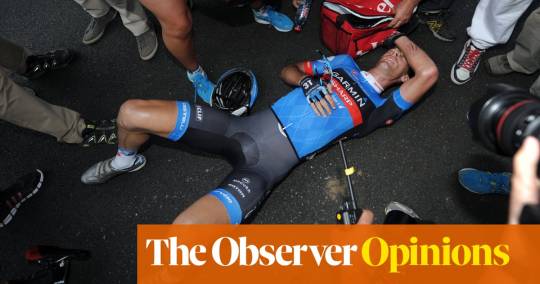
The Tour de France is big, really big. Thats the first thing that hits you, 4,500 people working on it, and only 176 of those are riding. There is no other bike race that even comes close to this scale. Yes, there are two other Grand Tours, the Giro dItalia and the Vuelta a Espaa, yet they are family affairs in comparison.
The nature of the course doesnt vary massively: its approximately 3,500km long, made up of 21 stages, mixing from flat transitional days to battles of epic proportions over some of the highest mountain passes in Europe. The rider with the least accumulated time over the 21 stages wins the overall and the coveted yellow jersey, of course, but winning only one of those stages can be career defining.
The yellow jersey, or maillot jaune, wasnt always around. This year is the 100th anniversary of its introduction, and the race itself is 116 years old. The history of the jersey itself is fascinating: a masterpiece in marketing by the Tours creator, the newspaper LAuto, which was printed on yellow paper. Here was a leading motoring publication tapping into cycling, the new big thing. Henri Desgrange, the editor, understood that by creating its own race it had exclusivity, and by making it a three-week race and inhumanely difficult it could create the most interesting narratives. Think of Big Brother, or Love Island, for newspapers.
The public lapped it up, circulation increased more than sixfold, the participants went from unknown eccentrics to national stardom, and the greatest bike race in the world was born.

David Millar, seen here in 2000 sporting the yellow jersey, won four individual stages at the Tour de France. Photograph: Doug, Pensinger/Allsport
It is this very nature of how and why the race was created that explains why it has become so important. It was never truly about the final results this isnt an event where winning is everything but about the human condition. Failure is often celebrated as much as success. Making it to Paris is for every rider, from the maillot jaune to the lanterne rouge in last, an emotional experience, and one that transcends racing.
This is what riding the Tour de France is truly about for me. Its about becoming part of the history of our sport. There are so many stories, myths and legends that surround and engulf it, from glorious heights to the deepest depths of darkness, and being part of it means you have earned the right to find your role.
It is this history that sets the Tour apart and what makes it so special. For me it was only ever about the history, and this is what I fell in love with when I was a kid growing up in Hong Kong. .
As a rider I was never stressed by the circus nature of the race in fact thats what I loved most and the noise made it easier for me to focus on what it was.
Sign up to The Recap, our weekly email of editors picks.
Most of the other races were dull in comparison because they didnt have the depth and didnt mean as much because they didnt have as much history. In France the fans dont go to watch the Tour de France riders, they go to watch the Tour de France event.
This year we will see a changing of the guard. Chris Froome looked on track to equal the greatest Tour racers record of five overall wins but his horrific crash on a recce ride at the Critrium du Dauphin last week put him out. I have no doubt he will be back for 2020.
So it falls to Geraint Thomas to defend the title he won in a magisterial manner last year. Although he also crashed out of his final preparatory race he did not suffer injuries that could qualify as affecting his chances. Team Ineos will be the team to beat. They know how to do it better than anybody with six overall wins in the past seven editions in the colours of Team Sky and, remarkably, with three different riders.
Yet, in all honesty, who wins doesnt really matter. The Tour de France is bigger than any individual, its become a cultural phenomenon, a Proustian memory of summer for the majority of the French population, omnipresent in the background of their whole lives, memories of carefree childhood Julys and shared timelines.
Its often referred to as the Circus, and maybe thats the best way to think of it: the greatest show of them all.
David Millar is a former Tour de France rider and partner in the CHPT3 bikes and clothing range
Original Article : HERE ; This post was curated & posted using : RealSpecific
There is nothing like riding the Tour de France and this is why | David Millar was originally posted by Advice4all News
0 notes
Text
The Second Coming of the Robot Pet
Mita Yun didn’t get into robotics to save the world. The lunar rovers she built as a student at Carnegie Mellon, and the software she developed as an engineer for Google—that stuff was just practice. The things Yun really wanted to make were friends.
Yun had hungered for companionship since she was a little girl in China. She’d begged her parents for a pet, but no dice. These were the days of China’s one-child policy, so no sibling either. Instead, Yun’s parents filled her room with a menagerie of stuffed animals, which she liked to imagine springing to life, their little paws dancing on her bedspread, their little bodies stuffed with possibilities.
In 2017, Yun quit her job at Google to start building the friend she’d always wanted. She started a company, called Zoetic, and recruited a few other roboticists to take her imaginary sidekick and turn it into a commercial product. Two years later, she's ready to introduce her creation: a small, interactive robot called Kiki, which goes on pre-sale later this month.
Kiki has pointed ears and a screen that projects big, puppyish eyes. It has a camera in its nose, to read your facial expressions, and it can perform little tricks to make you smile. If you pet it, Kiki sometimes cocks its head up or yelps in approval. In marketing materials, it's described as "a robot that touches your heart."
In Yun's dream world, everyone will have robopets like Kiki. Something like R2D2 from Star Wars or Baymax from Big Hero 6 or Marvin from the Hitchhiker's Guide to the Galaxy. Really, she'd like to see the whole world come to life, enchanted by some combination of robotics and magic. “Imagine if, in our office, the trash can has a character or the printer has a character,” Yun says. “Imagine everything coming to life. That is the dream I have.”
Yun isn't the only one dreaming. Robotics startups are rolling out more and more companion bots, designed for the sole purpose of friendship. As these machines increasingly become part of domestic life, those relationships usher in ethical questions: Are those bonds healthy? Can they be exploited? Should an emotive robot be given to vulnerable populations—the elderly, the mentally ill? Should we raise our children beside robots? And how will we feel when our new friends, who we may grow to love, break down and die?
Yun's vision for a robot playmate began around the time she got her first Tamagotchi. The Japanese company Bandai had introduced the egg-shaped "digital pets" in 1996, and the product exploded in popularity, reaching markets around the world. (Yun regularly overfed hers. “I think I was a bad Tamagotchi parent,” she says.) Two years later, the American electronics company Tiger created the Furby. And a year after that, Sony debuted Aibo, a robotic dog the size of a chihuahua.
Aibo could do normal dog things, like bark and perform a few tricks. It could also do robot things, like capture photos with the camera in its nose. (Eventually it was able to send them straight to its owner's phone.) Unlike a real dog, Aibo didn't need to be fed or groomed, and it signaled its mood with a color-coded lighting system on its head (green: happy; orange: angry). Like a dog, it could be “trained,” through punitive or affectionate taps on the head.
It also sold extremely well. In the week following Aibo’s debut, Sony received more than 135,000 orders. (Sony, which had begun work on Aibo primarily as a research project to test its learnings in robotics, was not prepared. The company had made only 10,000 units for sale.)
The interest in Aibo established a market for products that functioned not just as toys or novelties but as real companions. So the electronics companies made more and more. Panasonic started work on a robotic cat. Tiger, the Furby-maker, introduced a discount Aibo called the Poo-Chi. It sold more than 10 million units in its first eight months.
In the early 2000s, MIT psychologist Sherry Turkle began studying this first generation of children raised with robopets. It created an entirely new relational category—not just a doll or a stuffed animal, but something kids actively nurtured. Turkle wondered if bonds with these robopets, even the chintzy ones, could be real. Her research found that while children understood that toys like the Furby weren't "alive," they did form emotional attachments. When one Furby went on the fritz, it couldn't be easily swapped out for another. And kids felt empathy for it, too. One experiment from Turkle's group asked children to hold a hamster, a Furby, and a Barbie doll upside down for as long as they could. The children righted the hamster as soon as it started to squirm, and the Furby after about 30 seconds, when it started to shake and say things like "me scared." They held the Barbie upside down until their arms got tired.
And it’s not just robots that look like cute animals. Research in the field of human-robot interaction finds that we anthropomorphize pretty much anything that moves. "You see all of these studies where they make a stick move around and people ascribe all sorts of intentionality to the stick’s movement," says Kate Darling, a robot ethicist at the MIT Media Lab. "You can intentionally create a social robot that combines all of these triggers, and I think that naturally leads people to interact with it even though it’s an agent." Even when we know that a "pet" like Aibo can't think or feel, that doesn't stop us from treating it like something that does.
Two decades later, electronics makers are still capitalizing on that reality. There have never been more robots for companionship. To name a few: Kuri, a robot designed to rove around your home, looks like a cartoon character and expresses itself in emotive bloops. Jibo, a precursor to Amazon's Alexa, has the body language of the Pixar lamp; it's meant to tell jokes keep you company throughout the day. A Japanese start-up sells BOCCO, a bot that lights up when you speak to it and lets you know when your loved ones have opened the front door. An updated model, coming next year, blushes when you say "I love you." And Sony still makes the Aibo, retrofitted for the 21st century.
Kiki is closer to Aibo than Kuri or Jibo, because—as Yun puts it—it's fairly “useless.” It can’t set a timer or check the weather forecast. Yun thinks this is important, because she wants people to think of Kiki as a pet. Plus, she says, “the more useless something is, the more easy it is to have a bond.” (Yun's company, Zoetic, counts Caleb Chung, the creator of the Furby, as one of its advisers.)
Yun's team has spent years developing Kiki’s personality engine, a deep-learning program that allows Kiki to adapt to its owners preferences. Its reactions aren't hard-coded, meaning Kiki chooses how to respond based on what it has "learned" in the past. “Kiki can figure out what humor means to you,” Yun says. “It can do a funny trick and observe if you smile or not. And if you did, Kiki learns that this is working, let me try it again.” The team also built its own “expression system” to control Kiki’s eyes, based on advice from Pixar animators. Kiki can convey a complex range of emotions that includes gradations of anger, surprise, happiness, and sadness. And then there are the 16 touch sensors spread throughout its head and body. When you touch them, Kiki coos with delight. Yun has a habit of petting it during demos, and when she shows Kiki to me, the robot’s eyes turn into happy little half-moons. “I’m the owner of this guy, so he’s usually really happy to see me,” she says.
So far, people seem eager to have these kinds of relationships with bots. Sony still sells thousands of Aibos every year. The companies that make Jibo and Kuri both folded last year, but not before thousands of people brought those bots into their homes. Jibo owners have even formed groups to mourn the loss of their dying robot companion, who, lacking new software updates, has come to face a kind of digital dementia.
Darling, who studies ethics in robotics at MIT, says it's human nature to feel those bonds with machines that mimic emotion. "I don’t think it’s weird or sad that the robot doesn't love you back," she says. For some people, companion bots can be therapeutic, or can help them build better connections to the humans around them. There's some evidence that therapeutic robots like Paro, a fluffy seal used in some hospitals, can make people feel calmer and more social.
But where there is an emotional bond, there is potential for exploitation, according to Darling. How will companies leverage these connections for financial gain? Should there be rules about how companion robots interact with children or other sensitive groups of people? And if the rest of us wind up befriending robots, the way Yun imagines we will, how will those relationships reshape human psychology?
Kiki will go on pre-sale at the end of July, and Yun expects her first customers will be people “who have this dream of having a robot companion and who want to embrace this future where robots and humans are living together.” People like her. She also hopes Kiki will find a home with children and the elderly, both of whom she thinks could benefit from robot companionship.
For Yun, Kiki is just the beginning. She envisions a world where all of our objects are interactive and all of those interactions are friendly. Her work is deeply inspired by films in which future robots and humans live together as one. During her freshman year of college, Pixar made a film about a trash-compacting robot that roamed a lonely future-Earth with droopy, adorable expressions. Yun still thinks about it to this day. “WALL-E is like my dream robot,” she says. “It’s actually why I studied robotics: I wanted to build robots that are cute.” And so far, in the robopet revolution, cute seems to cut it.
Original Article : HERE ; This post was curated & posted using : RealSpecific
The Second Coming of the Robot Pet was originally posted by Advice4all News
0 notes
Text
Are businesses using Pride without giving back?

Image copyright Getty Images
It’s hard to miss the colours of the rainbow flag during Pride month.
Everything from High Street shops, supermarkets and banks are changing their logos, adding new window displays and selling special products.
But is this “rainbow washing”? In other words – is it jumping on a bandwagon without making any meaningful change?
Some LGBT campaigners are asking what brands actually do to support their community.
Years and Years singer Olly Alexander calls this “rainbow capitalism” and says it feels “especially icky” this year.
He told the BBC that on one hand “visibility is super-important” and he is grateful for the brands that “work responsibly with LGBT people” – but on the other side there has been a “corporate hijacking” of Pride.
Olly says brands should realise this can be “embarrassing” and that it’s not enough to donate money to LGBT charities.

Image copyright Olly Alexander/Instagram
He’s not the only one raising questions.
Other LGBT campaigners say this kind of support can feel tokenistic.
Tom Stevens, director of marketing at Pride in London, agrees that “sometimes it is icky”.
But he explains: “We can’t just say that all brand involvement in Pride is worrying or dangerous or bad news.”

Image caption Tom Stevens from Pride in London
What do businesses do to support Pride?
Pride in London receives around £650,000 from corporate partners, which works out at about two-thirds of its income.
Tom Stevens says this means a million people can celebrate for free.
But Pride in London does not accept money from just any business.
He explains: “We do have an ethical policy, that all the brands we work with need to meet, and make sure that they’ve got inclusive policies.”
This year there are 35 partners, including Tesco and Barclays.
Tesco is selling T-shirts and other products and says it’s raised £150,000 for LGBT charities.
It says this is about more than just Pride month, that actually its Pride campaign lasts for five months “to show support for our colleagues, customers and the communities we serve”.
Comedian Joe Lycett tweeted Barclays about their involvement with Pride.

Image Copyright @joelycett @joelycett
Report

Image Copyright @joelycett @joelycett
Report

Adam Rowse speaks for the bank, and says it does use its position to try to influence positive change.
He says: “We were a supporter of marriage equality bills in the UK and the US, and we supported colleagues in Hong Kong who played an active role to allow LGBT+ couples the same immigration rights as heterosexual couples.”
Budweiser will be handing out free cups along the parade route as part of its #FlyTheFlag campaign. Each cup has been designed to feature one of the nine different Pride flags – representing different groups, such as trans people and bisexual people.
The beer company says all of its profits from Pride in London will be given to its nine charity partners.
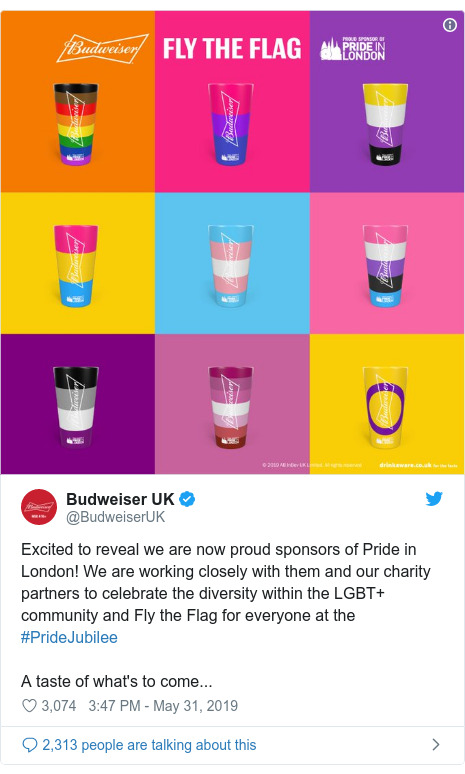
Image Copyright @BudweiserUK @BudweiserUK
Report

Image Copyright @BudweiserUK @BudweiserUK
Report

‘We love the love, but be authentic’
Other companies might not be official partners, but you wouldn’t know it from the High Street.
London’s Oxford Street – the busiest shopping street in Europe – is part of the parade route and it’s rainbow-tastic.
Almost every shop has some kind of colourful display and pride/proud/love-based slogan.
“Great, show the love. We love the love” says Tom Stevens.
But, he says, they have to be authentic.
He explains: “What we do need to do is scrutinise some of these companies and say ‘What else are you doing behind the scenes?’.
He would ask if companies donate to LGBT charities or if the flags and displays are instead led by marketing teams wanting to “jump on a bandwagon”.
He says: “Visibility is great, but if it ends the day after the Pride parade comes past, we cannot condone that.”
LGBT sandwich
Some High Street chains say they do provide genuine support.
For example, Marks & Spencer sells an LGBT sandwich.
It says it worked with LGBT employees to create it and will be donating £10,000 to a national LGBT youth homelessness charity, akt (The Albert Kennedy Trust).
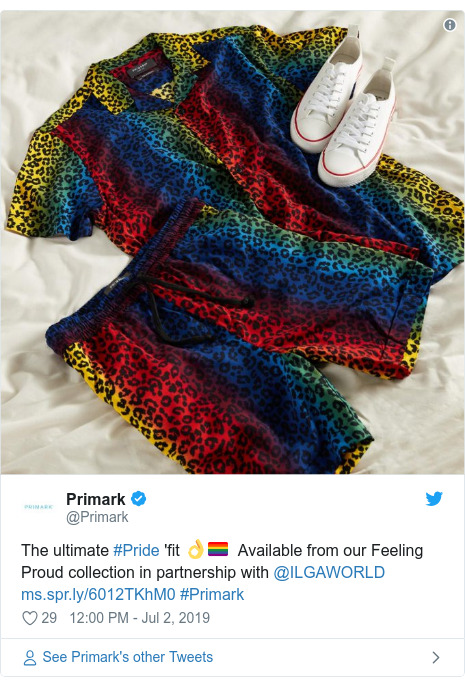
Image Copyright @Primark @Primark
Report

Image Copyright @Primark @Primark
Report

Last year Primark was criticised because its clothes were made in countries where homosexuality was illegal.
Now, it has a “Feeling Proud” range and is donating £150,000.
It says this will “help develop ways for LGBT communities to collectively advance equality worldwide”.
UGG is donating a quarter of the profits from limited edition rainbow slippers to LGBT media organisation, GLAAD.

Image copyright UGG
Image caption UGG’s ‘Fluff Yeah’ limited Pride slippers
London brewery Beavertown has released a limited edition Pride pale ale with proceeds going to LGBT+ youth charity Just Like Us, who champion equality in schools and universities using a network of LGBT+ role models.

Image copyright Georgia Gallant / Beavertown Brewery
Image caption Pride Gamma Ray pale ale can


Follow Newsbeat on Instagram, Facebook, Twitter and YouTube.
Listen to Newsbeat live at 12:45 and 17:45 weekdays – or listen back here.
Related Topics
LGBT
Pride
Original Article : HERE ; This post was curated & posted using : RealSpecific
Are businesses using Pride without giving back? was originally posted by Advice4all News
0 notes
Text
‘Major worries’ for Welsh foods after Brexit

Image copyright Halen Mon/Getty Images/BBC
Image caption Not all foods are equal – some of Wales’ best known food and drink are protected by the EU
Welsh food producers have “major concerns” their brands will not be safeguarded under a no-deal Brexit.
Some of Wales’ best known food and drinks – including Welsh lamb, laverbread and Caerphilly cheese – are protected by the EU’s Protected Geographical Indication (PGI) status.
However, the UK government has warned there are no guarantees that will continue after leaving the EU.
One Welsh levy body said 20 years of work “could be lost” without a deal.
When it comes food produce, it is all about making a name and whether it’s Champagne, Parma ham or Cornish pasties, those names are protected.
Gaining PGI status is highly sought after and can take years to attain. It took close to 11 years for the Melton Mowbray pork pie to be officially recognised.
The scheme gives legal protection against imitation, enhanced profile and the chance to get a premium price.

Image copyright Getty Images
Image caption The PGI scheme enables farmers to gain a premium price for specialist produce
It also aims to offer consumers confidence in what they are buying.
So there is growing concern at what will happen after Brexit – particularly if there is no-deal.
Halem Mon Anglesey Sea Salt said winning EU protection had been “very influential” in its exports.
“It’s recognised as a symbol of quality in the EU, especially by our markets in Italy and Spain, but also in places like Japan and the USA,” said co-founder Alison Lea-Wilson.
Brexit ‘concerning’ for EU Welsh produce
‘Maintain food status’ after Brexit
Protected food names: Quality or cartel?
“We are concerned about what will happen after Brexit because no one seems to know what will or might happen.
“We know our brand has been imitated before and, as a small business, would find it very hard to defend an action, particularly overseas.”
A report commissioned by the Welsh Government in 2015 found that Welsh lamb exports had increased “significantly” after gaining PGI status.

Image copyright HCC
Image caption EU protected Welsh produce varies from wine and cider to meat and fruit
According to research for the EU, those designated products were sold at a price 2.23 times higher than products without such trademarks.
It also said that the total sales of PGIs in 2010 was €54.3bn (£48.7bn).
“Having that status is central to everything we have been doing for Welsh lamb and beef for the last 20 years,” said Owen Roberts of Hybu Cig Cymru – Meat Promotion Wales (HCC).
“It provides gravitas and means products are recognised around the world as being up there with Champagne and Parma ham.
“We’ve based our entire marketing strategy on having that designation, to show quality and traceability, and there’s a danger of all that investment being undermined.”
Protected Welsh products
Welsh lamb
Welsh beef
Anglesey sea salt
Cambria mountains lamb
Carmarthen ham
Welsh cider
Conwy mussels
Caerphilly cheese
Denbighshire plums
Gower salt marsh lamb
Welsh laverbread
Welsh perry
Traditionally-reared pedigree Welsh pork
Pembrokeshire earlies potatoes
West Wales coracle-caught salmon
West Wales coracle-caught sewin
Welsh regional wine
Welsh wine
Puffin Produce Ltd said gaining protected status for Pembrokeshire Earlies had provided “significant economic and social” benefits across the county.
The UK government said it anticipated that the EU PGI schemes would continue to protect all current UK PGIs after the UK leaves the EU.
However, it has warned companies to prepare to re-apply in the case of a no-deal and it could also affect new products applying.
The UK government is also proposing a separate UK scheme following departure from EU that will “broadly mirror” the current system.
There has already been disagreement over the logo to be used, the worth of a new unrecognised scheme and the expense of potentially having to produce separate packaging for the UK and EU markets.

Image caption The Denbigh plum – Wales’ only native plum fruit – was the latest Welsh product to gain protected status
Welsh producers have said they do not want to be “subsumed” by a UK brand.
“Our research shows consumers respond far more positively to a Welsh flag than a British flag,” said Dr Roberts.
“Having a UK logo defeats the object of recognising something distinctly Welsh, or Scottish or specific to a region in England.”
Welsh jeans a ‘cult brand’
What food and farming is worth to Wales
Welsh plum given protected status
There has also yet to be any guarantee given that current EU funding for PGI products would be replaced under a UK scheme.
The Welsh Government said it was working with producers to move into a new scheme once the terms of Brexit hadbeen agreed.
A spokesman said: “There is already a precedent in place where countries outside of the EU can access the protected status scheme, such as Colombian coffee, which is protected in the EU market.
“If the UK left without a deal there is no reason why existing Welsh products should not retain their current GI status and any potential new products could seek protection as a third country after we leave.”
The UK government’s Department for Environment, Food and Rural Affairs said it recognised the “crucial role that GIs play in protecting the provenance and heritage of some of our best-loved food and drink products, from Anglesey sea salt to traditional Welsh Caerphilly”.
“The UK is ready to launch its own GI schemes at the point at which EU rules cease to apply in the UK.”
Related Topics
Gower
UK farming
Food
Wales economy
Wales Brexit
Wales business
Brexit
Original Article : HERE ; This post was curated & posted using : RealSpecific
‘Major worries’ for Welsh foods after Brexit was originally posted by Advice4all News
0 notes
Text
The Pioneers review: David McCullough on Ohio and a road less travelled
An absorbing book about the settlement of the Northwest hints at an alternative America that never came to pass

For many Europeans (and Americans as well), the term pioneers probably evokes images of covered wagons and homesteaders on the vast prairie, of emigrants settling the west, amber waves of grain, perhaps even an anachronistic bit of John Ford. That is not this book.
David McCullough puts the story much earlier, with the founding of what became the state of Ohio, and ends it during the civil war.
At the Treaty of Paris in 1783, ending the American revolution, the Americans led by future president John Adams insisted on the cession of the lands north-west of the Ohio River to the Mississippi, the Northwest Territory. Settlement began in 1788.
Those first settlers were the foremost pioneers in both the literal and figurative sense, facing hard work clearing land for agriculture, the threats of disease and war with Native Americans, among other dangers.
Its an important story. Ohio has always been a pivotal state and the founding of Marietta marks the beginning of organized settlement in the successive western frontiers. (Daniel Boones first emigrants to Kentucky left in 1773 but did so illegally, thanks to the Proclamation of 1763 limiting settlement to east of the Appalachian mountains.)
The characters involved, including the Rev Manasseh Cutler (among the first and most successful lobbyists as well as a noted divine); Revolutionary war general Rufus Putnam; and the Irish-born Harman Blennerhasset, who schemed with former vice-president Aaron Burr to split the republic, hold the readers interest.
Equally, the settlement of the Northwest defined several important themes in American history. Notably, in the Northwest Ordinance of 1787 Congress banned slavery in the territory and set aside land for public schools. As McCullough notes, this began what he terms the American ideal a future in which free, educated people would form towns and bring order to the frontier. In 1802, Ephraim Cutler, the Rev Cutlers son, arose from his sickbed to cast the deciding vote in the Ohio state constitutional convention, preventing slavery there surely one of the most consequential legislative votes in American history.
McCulloughs story of Campus Martius, the first settlement at what is now Marietta, offers a tantalizing glimpse of a road not taken, of a future more defined by communitarianism than individualism:
They were united in bonds of friendship like one great family, bound and held together in a common brotherhood by the perils which surrounded them. In after years, when each household lived separate in their own domicil, they looked back on these days with satisfaction and pleasure, as a period in their lives when the best affections of the heart were called forth and practiced towards each other.
If this harkens back to similar remembrances of Plymouth or 17th-century Boston, many of the first settlers of Ohio were the descendants of Puritans who wanted to build a town on the New England type.
Perhaps it was inevitable that an expansive frontier and a restless people would lead to individualism becoming the dominant American ideology. But it is among the frustrations of this book that McCullough does not tease out the contrast more, instead simply passing along to the next events.

David McCullough, pictured in his library in West Tisbury, Massachusetts. Photograph: Steven Senne/AP
The book resulted from the delivery of an address at the bicentennial of Ohio University and McCulloughs own research at Marietta College, in the town founded by the settlers along the beautiful river. Its a superb regional history, with well-painted glimpses of the hardships and joys of frontier life and portraits of important early settlers. But overall it misses the chance to expand on broader themes hinted at throughout the book.
There is a place for regional history among other things, it would help Americans understand some of the roots of our enduring differences but placing this narrative within a broader context, even of the settlement of the other states that became the midwest, would have made a stronger, more enduring work. The book should have been called Ohio! or something similar. One senses the title was dictated more by a publishers marketing department than the books contents.
McCullough is among the most thoughtful and thorough historians of the past two generations. Read 1776, John Adams or the magisterial (and highly relevant) Truman to get the true measure of this great American mind.
Original Article : HERE ; This post was curated & posted using : RealSpecific
The Pioneers review: David McCullough on Ohio and a road less travelled was originally posted by Advice4all News
0 notes
Text
Guardian’s gender pay gap falls to 4.9%
Difference in median hourly pay between women and men in editorial is 5.9%
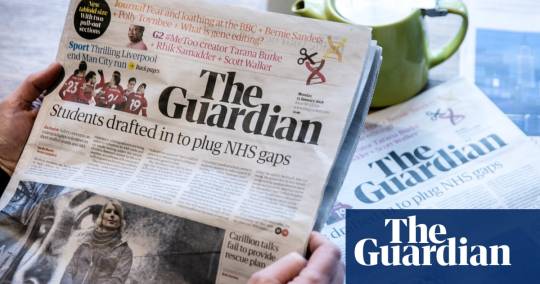
Guardian News & Medias gender pay gap has fallen to 4.9% calculated by median hourly pay from 8.4% a year ago, according to figures released by the company on Tuesday.
Women working in editorial at GNM earned 5.9% less an hour on average than men, an improvement on a 6.4% gap a year before on a median basis, which takes the mid-point when all wage rates are lined up from the biggest to smallest. The gap for non-editorial roles, such as marketing and distribution, was 18.6%, down from 19.1% a year before, on the median calculation which reduces the effect of one-off outliers.
The overall pay gap for GNM, which is based on a company pay snapshot of more than 1,500 UK employees taken on 5 April this year, compares with a 6.7% median gap at the BBC, also reported on Tuesday. The median pay gaps at the Financial Times and Telegraph Media Group for 2018 were 18.4% and 23.3% respectively. Both publishers have yet to release their 2019 figures.
On a mean basis which takes the total paid to each gender and divides it by the number of employees of that gender the GNM pay gap is 11%, down from 11.7% last year.
Among those who received bonuses, the median gap was 2.8% widening from a zero gap last year. But the gap narrowed on a mean basis to 27.5% from 34.2% in 2018.
GNM, the parent company of the Guardian and the Observer, said that its pay gap was the result of employing more men in the top half of the organisation in pay terms and not enough women in the highest-paid and most senior roles. There are also more women in lower-paid administration, sales and marketing roles.
The top half of the organisation is now 41% female, compared with 36% in 2017, but 63% of staff within the lowest-paid quartile were women, up from 61% in 2018. GNM has said it is aiming to achieve a 50:50 gender balance in the top half of the organisation by 2022.
Katharine Viner, the GNM editor-in-chief, and David Pemsel, the Guardian Media Group chief executive, said the company was making some encouraging progress as it was recruiting more women into the top of the organisation and supporting women to progress in their careers within the business.
While year on year we see some fluctuation in our results, the overall trends are determinedly in the right direction. Were pleased that the range of company-wide measures we are taking appear to be setting us on the right path, Viner and Pemsel said in a joint statement.
GNM is publishing the data under the governments compulsory gender pay gap initiative, which was introduced in 2017 and requires all private and public sector organisations and charities with more than 250 employees to submit annual figures.
The gender pay gap measures what men and women working for an organisation earn regardless of roles, rather than men and women in the same role.
Original Article : HERE ; This post was curated & posted using : RealSpecific
Guardian’s gender pay gap falls to 4.9% was originally posted by Advice4all News
0 notes
Text
This 4th of July, Americans are fighting over what ‘American’ should mean

(CNN)When President Donald Trump gives his military-themed “Salute to America” on Thursday, he’ll stand in front of the Lincoln Memorial, where the words of President Abraham Lincoln’s greatest speech, his second inaugural address, are etched in stone.
For Trump’s speech, there will be American flags everywhere. Count on it. It’s not out of the question that he will sidle up and hug one, something he’s done before.
Most Americans (70%) said they were extremely or very proud to be Americans in an annual Gallup poll released this week. That sounds great except that the 45% who said they were extremely proud is the lowest since Gallup started asking the question on the Fourth of July — in 2001, as it happens.
It turns out there’s almost nothing more divisive to a national identity than building a presidency around nationalism.
Trump revels in putting his definition up against other people’s. That’s why he stoked his fight with kneeling NFL players for so long. And that’s why so many are frustrated that he’ll hold a rally on the National Mall — a “Salute to America” — on the Fourth of July.
He’s saluting his own version of America and he’s not very charitable to anyone else’s, which can be an offensive thing at a time when people are basically streaming to the US as refugees from Central America. It can be offensive when there is an undercurrent of racism in his acceptance of white nationalist protesters or his defense of Confederate statues.
But this week it was Republicans like Senate Majority Leader Mitch McConnell and the President’s son Donald Trump Jr. who were offended by reports that Nike had pulled a sneaker featuring an early version of the American flag because former NFL quarterback Colin Kaepernick said that marketing a version of the flag from a period of history featuring legal slavery was offensive.

Trump’s flag hug goes viral
The Betsy Ross flag, with its circle of 13 stars for the original 13 Colonies, is named for the possibly apocryphal story of the seamstress who made it.
The ensuing uproar was led by McConnell, who said Tuesday that “If we’re in a political environment where the American flag has become controversial to Americans, I think we’ve got a problem.”
McConnell is interesting on this issue. He’s a great supporter of free speech, be it in the form of campaign dollars or flag desecration. He is a leading voice against a constitutional amendment to ban flag burning.
In fact, back in 2006, the Senate failed by one vote to support an amendment to outlaw flag burning. McConnell cast that vote. He was one of three Republicans to vote no. Of the others, former Sen. Lincoln Chafee of Rhode Island lost a reelection campaign and is no longer a Republican, and Bob Bennett of Utah lost a primary. He has since died.
McConnell can control what the Senate votes on, so it’s unlikely he’ll allow a proposal introduced last month by fellow Republicans to vote again on an anti-flag-burning amendment to reach the Senate floor, although Trump is all in favor of it.
“All in for Senator Steve Daines as he proposes an Amendment for a strong BAN on burning our American Flag. A no brainer!” Trump tweeted on June 15, the day after Flag Day.
Nike’s decision, which a spokesman said was made to not offend people celebrating Independence Day, prompted Arizona Gov. Doug Ducey to move to pull back tax incentives the company was set to receive for opening a plant. It’s a twist on liberal efforts to pull business from states moving to restrict abortion rights.
Then California’s Gov. Gavin Newsom and New Mexico’s Gov. Michelle Lujan Grisham reminded Nike their states are open for business.
Trump Jr. sensed an opening to tie Nike to the brewing Republican accusation that Democrats are pushing socialism with the proposals for nationalized health care and student debt forgiveness. He tweeted an imagined pair of Nikes emblazoned with the Soviet flag.
It shouldn’t be lost in all this that while Kaepernick is employed as a Nike spokesman, he no longer gets to be a football player — while no one is kneeling during the National Anthem before NFL games anymore.
Similarly, it was Megan Rapinoe who knelt before US Soccer games in solidarity with Kaepernick, who was trying to make a point about racial and social justice. That ended after the US Soccer Federation voted almost unanimously to require players and staff to stand during the anthem.
This week, Trump, the purveyor of nationalism, joined in a Twitter war with Rapinoe after the release of a video in which she said she wouldn’t be visiting the “f***ing White House,” although she didn’t expect Trump to invite the team if it won the Women’s World Cup final.
That feud simmered — Rapinoe scored two goals after he said she should finish the job and win the final before talking about White House invitations. She was then benched with a mild hamstring strain and watched while her teammates defeated England.
The team’s general excellence — and not the row with Trump — has led their jersey to become the best-selling soccer top in history. People frustrated by not having access to Nike’s Betsy Ross sneakers might consider buying a red, white and blue USWNT jersey, also made by Nike, instead.
So HBD, America. Let’s keep it together. Stop worrying about the flag shoes Nike won’t sell and take a look at the soccer jersey it does.
Original Article : HERE ; This post was curated & posted using : RealSpecific
This 4th of July, Americans are fighting over what ‘American’ should mean was originally posted by Advice4all News
0 notes
Text
A lightning strike during a South Carolina holiday celebration leaves one person dead and 11 hurt

(CNN)A lightning strike killed one person and left several injured during a Fourth of July celebration in South Carolina.
One man went into cardiac arrest and was taken to a nearby hospital, where he died in the emergency room, Hucks said. He was identified as Ryan Gamble, 44, of Andrews, a town in Georgetown County.
Eleven others were injured, said Amy Stevens, vice president of marketing for Tidelands Health. Three have been treated and released, and eight were admitted to the hospital.
Andrews Mayor Frank McClary was celebrating the holiday with his family when the lightning struck.
“My thoughts and prayers are with the families affected by this,” the mayor said. “We did lose a young man, and that is a horrible thing.
“We are going to have to be aware of what goes on with these pop-up thunderstorms.”
McClary said the county has an emergency operations center that sends out early warnings, but workers there did not anticipate the storm to be as violent as it was.
Original Article : HERE ; This post was curated & posted using : RealSpecific
A lightning strike during a South Carolina holiday celebration leaves one person dead and 11 hurt was originally posted by Advice4all News
0 notes
Text
Magid Magid: ‘I don’t intend to try to fit in’

Image copyright Chris Saunders
Image caption Magid Magid is probably best known for “banning” Donald Trump from entering Sheffield

Magid Magid made quite an impression as he arrived for his first day at the European Parliament in Strasbourg. Wearing a baseball cap and a T-shirt bearing an anti-fascist slogan, the newly elected MEP said he was asked to leave the building.
Who is Mr Magid and what barriers has the 30-year-old Somali refugee from Sheffield overcome to end up as a Green Party MEP?

Image caption Mr Magid donned his trademark yellow baseball cap for his first day at the European Parliament
“I know I’m visibly different. I don’t have the privilege to hide my identity. I’m BLACK & my name is Magid. I don’t intend to try fit in. Get used to it!”
This was Mr Magid’s response to being asked to leave the European Parliament building by someone he said he believed to be an official.
While the European Parliament said no member of staff was involved, Mr Magid – one of six MEPs for Yorkshire and the Humber – said the incident “says a lot about what people think the stereotypical politician is meant to look like”.
And it’s hard to argue he doesn’t have a point – of the new European Parliament’s 751 members, less than a dozen are black.
To the people of Sheffield, where Mr Magid recently finished a year as the city’s Lord Mayor, his straight talking will have come as no surprise.

Image copyright Mark Howe/Sheffield City Council
Image caption Mr Magid has become a source of inspiration for young people across the world
From his eye-catching style – Dr Martens and baseball caps coupled with the 18-carat gold chain of office – to his back story – the Somali refugee who came to the UK aged five – he was nothing like the stereotypical image of a Lord Mayor.
During his 12 months in office he hit the headlines time and again, most notably for “banning” US President Donald Trump from Sheffield.
Born in Burao, in northern Somalia, Mr Magid and his family left the war-torn country in 1994 in search of “a better life”. After six months in a refugee camp in Ethiopia, the family – his mother and five older siblings – settled in Burngreave in Sheffield.

Media playback is unsupported on your device
Media captionIn 2018, Magid Magid told the BBC about how he went from an Ethiopian refugee camp to Sheffield Lord Mayor
He went to Sheffield’s Fir Vale School, where he said he was “just like your average child”, before studying aquatic zoology at the University of Hull.
Mr Magid ran a digital marketing business before being elected as a councillor in 2016, and was appointed Lord Mayor last year.

Image copyright Family photo
Image caption Magid moment: At home in Sheffield as a young boy
The role is a ceremonial one, but Mr Magid was determined he would be remembered as more than just a figurehead shaking hands at church fetes.

Image caption He kept a pair of personalised Dr Martens boots and Donald Trump loo roll on display in the Lord Mayor’s parlour
Asked if he set out to shake things up, he said his very existence in local government was “radical to a lot of people”.
But Mr Magid said he would sooner face the flak – things were thrown at his official car and he was sent racist hate mail and death threats – than stay silent.
“As long as I am making people feel something, connect or engage, even if that is calling me [names], at least I’m evoking some interest in the role and people are caring,” he said.

Image copyright Magid Magid
Image caption Mr Magid received a number of threats during his time as Lord Mayor
His approach to the role polarised public opinion.
The Lord Mayor’s stance on Mr Trump prompted some to say they were “embarrassed” to admit they were from Sheffield, while others accused him of abusing his position.
More acerbic comments were aired in a series of letters to the local newspaper, shortly after his appointment.
One reader said he represented “everything that is wrong with our once great city”, while another said the role should be “reserved to a person of white, English descent”.

Image caption Mr Magid said he felt compelled to stand as an MEP at a “pivotal moment” he sees as a “battle for the soul of Britain”
Mr Magid readily acknowledges he is “not everyone’s cup of tea”.
“People really either love me or they hate me, but either way they’ve got a passionate opinion,” he said.

Image copyright Magid Magid
Image caption He is well known for wearing T-shirts bearing political slogans
Speaking in May, Mr Magid said he keeps a message on his phone from a Somali refugee living in Austria who said she had been inspired by him to stand in her local elections.
His story also reached pupils at Crocker Farm Elementary in Amherst, Massachusetts.
Classroom assistant Jean Fay said two youngsters, one from Sri Lanka and the other from Cape Verde, had spent time researching his rise.
“The students were excited that someone so young like them, someone who is an immigrant like them, who speaks a different language like them, can be someone who is elected by a large group of people and can make a difference in the world,” she said.
“Seeing someone like Magid, who they can relate to, makes them believe this is possible.”
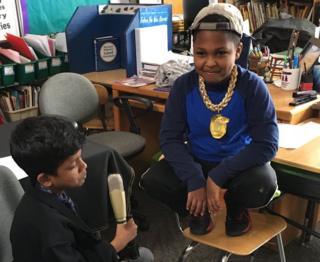
Image copyright Jean Fay
Image caption Young students in the US carried out a research project on the politician
Closer to home, in Burngreave, the deprived part of Sheffield where Magid grew up, he has been hailed a “hero” by Safiya Saeed. She is the founder of community group Big Brother Burngreave, which, among other things, aims to divert teenagers from violent crime.
She said young people in her group, originally from places including Somalia, Yemen, Ethiopia and Congo, could relate to the fact Mr Magid had endured racism and prejudice.
“For many of them, for many of their parents, politics is not something they engage with, but Magid has made it fashionable,” Ms Saeed said.
“He’s shown you can wear your own gear and trainers – you don’t have to be in a suit.
“That’s real for them. It’s shown them [politics] is no longer just a white person’s position.”
Protests mark opening of European Parliament
Meet the European Parliament’s youngest ever MEP
Flamboyant Lord Mayor to step down
In the view of Kate Dommett, a senior lecturer in the public understanding of politics at the University of Sheffield, Mr Magid’s actions “completely redefined” the role of Lord Mayor.
“There have always been very minimal expectations about what the mayor in Sheffield did, but he came in and just immediately challenged those expectations, behaving in a very, very different way,” she said.
“It’s quite unprecedented for essentially a local councillor who has only ceremonial powers to have that kind of national profile, and he’s built that out of nothing.”

Image copyright Joanna Hall
Image caption Joanna Hall says young people often struggle to have their voices heard
Sheffield youth councillors Joanna Hall, 15, and Jude Smith, 14, said previous Lord Mayors did not stand out and largely failed to listen to young people.
“We’ve had real difficulty getting through to people in power,” said Joanna.
“There have been a lot of people that are just there for show.”

Image copyright Jude Smith
Image caption Jude Smith says Mr Magid is a “beacon of hope”
Jude, who says he chats with Mr Magid on Instagram, said: “I have mates who were disinterested in politics who have now jumped into it because of him.
“I think he’s been a massive beacon of hope.”
Related Topics
Sheffield
European Parliament
Magid Magid
Sheffield City Council
Somalia
Original Article : HERE ; This post was curated & posted using : RealSpecific
Magid Magid: ‘I don’t intend to try to fit in’ was originally posted by Advice4all News
0 notes
Text
Mom Of Two Explains What It Feels Like To Be Sober For Two Years And People Instantly Relate
We have all been to situations where we don’t want to do something, we know why but just can’t be bothered explaining ourselves to everyone else, knowing that would sure suck us in an endless conversation about the decision and ain’t nobody got time for that, right?
Therefore, it really takes courage to expose yourself in sensitive topics and even more so, when you’re doing that on the Internet. This didn’t put off this brave mom of two, Celeste Erlach about an issue many can relate but rarely speak of and the Internet loves it. This is not the first time she’s drawn attention to serious issues parents face though.
This is Celeste Yvonne – a writer, Instagramer, marketing guru and most importantly a mom of two
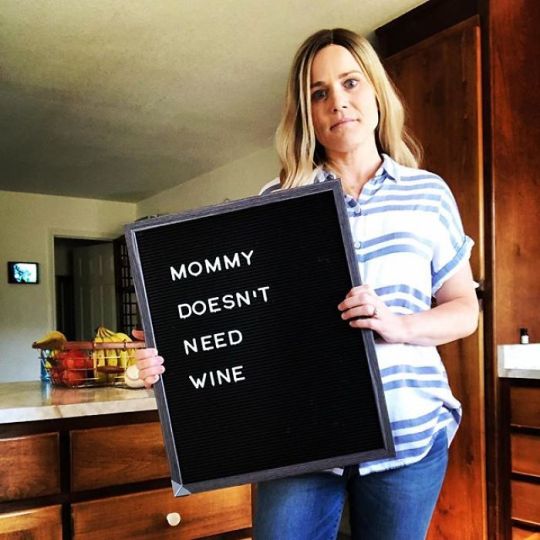
Image credits: andwhatamom
In her blog, she mostly writes on parenting in an excruciatingly honest manner that every parent can relate to. She also tries to bring awareness to social issues that are usually kept under wraps. Her latest topic of quitting drinking has drawn a lot of attention since her decision to talk about it publically.
About a year ago she decided to go public about being “alcohol-free”

Image credits: andwhatamom
In an interview with Bored Panda, Celeste said she made the decision to quit drinking completely in December 2017 after realizing she couldn’t be the mom she wanted to be with three glasses of wine in her system almost every evening.
And her sobriety post went viral




Not drinking had a huge impact on her family life

Image credits: andwhatamom
Her relationships with her kids and her spouse have absolutely grown. “I’m less distracted and I’m more present. I still get angry, I still get frustrated, but I don’t experience the tremendous guilt that came with over-drinking around my family. I don’t worry my kids would always remember me with a drink in my hand, and then as they grow up my own worry about what kind of effect that would have on their own decisions as adults. ”
It wasn’t an easy decision to go public about it though

Image credits: andwhatamom
It took Celeste a year to go public with her decision to stop drinking. But it was all worth it as she is now getting messages every day, thanking her for bringing awareness to this and talking so openly about her own journey.
She has advice for people tackling similar problems

Image credits: andwhatamom
The mom of two admits she was very reluctant to talk about her decision to quit drinking in the first year but now she feels more confident about it every day. Despite believing that “No” is a complete sentence, she admits people are fascinated with a person’s choice to not drink, and a “no” response often gets volleyed back with a “how come?” Her recommendation is saying “it’s for personal reasons” and changing the topic. “But as I become more confident, I’ve discovered it’s a lot easier for me to say “I quit drinking a year and a half ago and it’s the best decision I ever made.” I love my success story and it’s exciting to share my journey with others. ” she adds.
And refuses to be a member of “mommy wine” culture for any longer

Image credits: andwhatamom
Sometimes it may seem moms, in particular are being targeted by alcohol companies through advertising and in social media with the so-called “mommy wine culture.” and it’s dangerously effective. Celeste herself admits having used the “mommy wine” memes and jokes as justification to her overindulgence and definitely feels like the minority now that she’s not drinking. “Almost all my mom friends drink and swear by their wine. The difference between them and me was I never wanted to stop with just one drink,” she told Bored Panda.
Women on the Internet could instantly relate









Almost finished… To complete the subscription process, please click the link in the email we just sent you.
Original Article : HERE ; This post was curated & posted using : RealSpecific
Mom Of Two Explains What It Feels Like To Be Sober For Two Years And People Instantly Relate was originally posted by Advice4all News
0 notes
Text
Why Everything From Transit to iPhones Is Biased Toward Men
Caroline Criado Perez is a social activist and journalist who, in 2017, successfully campaigned for British banknotes to feature the image of Jane Austen, after the Bank of England said it would be phasing out Elizabeth Fry's portrait in favor of Winston Churchill. Criado Perez has also been a vocal critic of Twitter’s policies around abusive tweets, since she herself has been the target of severe Twitter harassment. And her Women’s Room database of female experts tries to ensure that more women are tapped as sources in the media.
In her new book Invisible Women, Criado Perez examines different elements of the modern world that appear to be designed with less consideration for women: Transportation systems, medical devices and treatments, tax structures, consumer products, even the smartphones and voice-recognition technologies we use every day. The 321-page book is a rapid-fire delivery of data sets, making it more of an academic tome than a light and hopeful read to take with you on summer vacation. But despite the occasional meandering, Invisible Women often arrives right back at the same seemingly inevitable conclusion: There exists a real gender data gap that is “both a cause and a consequence of the type of unthinking that conceives of humanity as almost exclusively male.”
Criado Perez spoke to WIRED about the book. The conversation has been edited for length and clarity and includes information provided in follow-up emails.
Lauren Goode: My first question is this: What was the moment for you that made you think, OK, this is the time for me to write this book? You’ve been observing and covering these issues for a very long time, but I’m wondering if there was something in particular that made you want to publish this book at this moment.
Caroline Criado Perez: I first came across the gender data gap in the world of medicine in 2014, when I was writing my first book. I was just so shocked that this was an issue in the 21st century, that doctors were misdiagnosing women because the symptoms of our heart attacks don’t confirm to those of men. And that women were more likely to die and more likely to be misdiagnosed. Around that same time I also found out that we don’t tend to involve female humans or animals or cells in medical trials, and the result of that is women have less effective treatment and more side effects.
That was just really gobsmacking. So really it was that, and me not being able to get it out of my head. And because I knew it was happening there, I realized it was happening in other places. Since I’d studied behavioral and feminist economics at the London School of Economics, I already knew about the default male in that area, but I started discovering all of these other areas where it was popping up. The more I found out, the more learned about data gaps in technology, and car safety design … and even data gaps in refugee policy. And so eventually it was just that I had so much information that the only way to cover it was to write a book.
LG: Can you talk specifically about the technology devices you highlight in the book, and how biased data sets have informed biased design? I always think about giant smartphones, because as a reviewer I often note that they just don’t fit in my hands all that well. But then in marketing, the companies might use professional athletes with giant hands holding the phones, so of course it seems small in comparison.
CCP: The category of smartphones is a massive bugbear of mine because I actually got RSI [repetitive strain injury] from an iPhone 6. And I now am stuck with an iPhone SE which I can’t upgrade. The only small phone they had, they discontinued, and it’s the only one that fits my hand. It’s incredibly frustrating. And then later when [Apple] introduced Siri, you could use it to find a viagra supplier but not an abortion clinic. So there’s all sorts of examples like that, where there’s not as much thought being put into, you know—female customers exist. Another example is VR headsets being too big.
Criado Perez’s new book Invisible Women is out now.
Abrams Books
But to me the most worrying examples are about algorithms rather than hardware. Because with hardware, it’s kind of easy to see how it is affecting us or not fitting us, and so it’s relatively easy to fix. What’s more concerning to me are algorithms being trained on highly biased male data sets, and the way these algorithms are being introduced in all sorts of areas of our lives. There doesn’t seem to be much understanding amongst the people who are coding these algorithms about the issues with the data they are training them on. That goes from voice recognition systems that don’t recognize female voices, to online dictionaries, to algorithms deciding whether a certain CV will ever reach human eyes.
And this is often proprietary software, so we don’t always get to see whether gender bias is being accounted for. So we’re outsourcing the future to private companies that are using biased data sets, and there’s no way of knowing what’s going on there.
LG: Transportation, and really more broadly city planning, is something else you cover quite a bit in the book. You point out that in some societies, women walk more than men, and that the way they lump trips and errands together—referred to as trip-chaining—and even their safety isn’t really considered. How do you fix something like that when the transportation systems are so firmly embedded?
CCP: There are a number of things that can be done. The obvious one is to move bus routes because, as you say, things like subways are fixed and it’s much more expensive to change them. When new lines are added and new stations are added, absolutely those things should be taken into consideration. But bus routes are very easy to change and the thing about buses is that, in some places, women are much more likely to use buses. That’s one easy way of addressing the male bias in transport infrastructure in a relatively short order.
More long term, it really is about the design of cities themselves and looking again at zoning laws. One of the big problems with the way we’ve laid out cities is that they’ve been laid out in such a way to serve the needs of this mythical male breadwinner who has a wife home in the suburbs. This man drives to work and conceives of home as a place of leisure, so you don’t have as many services; you can just have a residential area. It’s this idea that you just go home and you sleep. And it’s completely untrue to how women and people live their lives. They’ve got to take kids to the doctor, to school, get groceries, check in on a relative …all the things we are doing on a daily basis requires a lot of complicated logistics.
In some societies women are also less likely to have access to a car than a man; if a household has one car, men dominate access to it. So women use public transport, but the public transport hasn’t been designed for unpaid care work. The ridiculous thing about this as well is that by making it difficult for women to complete their unpaid care work, it makes it much harder for them to engage in their paid work. In the US, for example, female labor participation has been dropping behind other developed countries, and there’s a need in America for women to engage more in the paid labor force. But nothing is being done to help them do that in really this very simple ways, enabling them to do the unpaid work that has to get done.
LG: When I think about bias in transport design, I think about this breastfeeding pod I saw last year in an airport. It’s this Zappos-sponsored pod in the middle of the airport terminal walkway for women to nurse in. The person I was traveling with at the time said something like, “Isn’t that an interesting idea that there are these pop-up mother’s rooms?” And my thought was, “Isn’t it terrible that adequate family rooms weren’t designed in the airport back when it was originally built?”
CCP: I sort of take it one step further and wonder why we have to lock women up in pods to feed their children. It seems bizarre. I’m not sure I see that as progress in any way, shape, or form. I can’t think of the word. I’m quite horrified by it … And I know obviously some women would want to use them, but also, if a woman wants to put a muslin over her baby that should be enough.
LG: In the book when you refer to your campaign to get the Bank of England to put a woman on its banknotes, you wrote something that comes up often in the book. You wrote, “No one meant to deliberately exclude women. It’s just what may seem objective is actually highly male-biased.” At what point though—especially now that we have access to more data sets—at what point does the ignorance of data become deliberate?
CCP: That’s a very good question, and it reminds me of a quotation someone sent to me on Twitter the other day. It was something about how ignorance or a refusal to know is an epistemological political project. This is something [feminist scholar] Nancy Tuana argues. I think that that’s such an interesting way of framing it. That’s not the way that I frame it exactly, because I do think that even when … how should I say this? So, I think there are two things.
First of all, a lot of the male bias we come across shows they just forgot to factor women in because it was a male-biased team and they just sort of forgot we exist. It happens all the time by accident. And then there is simply just not knowing what women’s needs are.
For example, I always think of Sheryl Sandberg going in to ask the head of Google to put in pregnancy parking and he said, I never thought about it, of course. And she says he feels bad for never having thought about it. But that highlights the need for diversity. Because it’s perfectly normal that a guy who has never been pregnant, or also a woman who has never been pregnant, to not think about that. Of course, they could have been collecting data on the needs of women employees. But nevertheless, it wasn’t an act of malice.
The point where I start thinking about this as a political project is when you start getting to the excuses. One of the things I’m asked most about the book is, “What is the example that made you the most angry?” And I can’t really choose one. But the thing that does really make me angry and never ceases to is the excuses. At that point it’s not forgetting. It’s about excluding. For example, with car manufacturers, the decision was made in the EU to finally introduce a female car crash system and it’s just a scaled-down male dummy, and it’s only used in certain tests and in the passenger seat. How did that decision happen? That’s not forgetting; that’s a deliberate act.
LG: Do you see a world in which technology can actually help solve some of these problems?
CCP: Maybe. I think that certainly technology has historically helped women. It has lessened the amount of time that women have to spend doing certain things. One of the examples I talk about in the book is stoves. Most women in low-income countries still cook using the three-stone stove, which gives off incredibly toxic fumes. So the stoves we have in modern homes are absolutely incredible when it comes to helping women when it comes to both the health burden and the time burden they reduce.
There is hope, though I don’t know what that technology will be because I‘m not an inventor. But I suppose the answer is, it depends on who is going to be allowed to do the inventing. The large majority of VCs are men, and they are just much more likely to give funding to male entrepreneurs. And male entrepreneurs are much more likely to develop technology that helps men.
And that, again, is not a conspiracy. That’s just because you’re more likely to develop something that fixes a need you yourself have. Female entrepreneurs are more likely to develop tech that helps women. And that’s great, but they’re not getting the funding. And that goes back to the data gap. It’s just this catch-22. And that’s where the concern is: Because we don’t have the data and because the mostly-male VCs don’t recognize it, will technology be able to solve the problems because will we give the women the money and resources to do it?
When you buy something using the retail links in our stories, we may earn a small affiliate commission. Read more about how this works.
Original Article : HERE ; This post was curated & posted using : RealSpecific
Why Everything From Transit to iPhones Is Biased Toward Men was originally posted by Advice4all News
0 notes
Text
Megan Rapinoe Slams Decision To Put 2 Men’s Matches The Same Day As World Cup Final
Megan Rapinoe considers Sunday to be the final insult.
Just a few hours after the United States and the Netherlands meet in the Women’s World Cup final in France, Brazil or Peru will celebrate winning the Copa America, South America’s men’s championship. And then at night, the United States or Mexico will win the CONCACAF Gold Cup, the men’s title of North and Central America and the Caribbean.
A TV triple of championships for some is yet another slight for others.
“It’s ridiculous, and disappointing, to be honest,” said Rapinoe, the star American midfielder.
FIFA said playing the three finals on the same day would boost attention for all.
“The scheduling of the different events has gone through a comprehensive consultancy process, which has involved all key stakeholders and taken into account different aspects of the women’s and men’s international match calendars,” the governing body said in a statement. “It is a rare and exciting occurrence.”
CONCACAF President Victor Montagliani told The New York Times, however, the decision to schedule the Gold Cup final for Sunday was not deliberate and was due to a “clerical error.”
“It’s terrible,” said former American midfielder Aly Wagner, now Fox’s lead World Cup match analyst. “It is so disturbing to me that the Women’s World Cup does not have its own day to stand on its own and have a final to highlight these tremendous athletes and their work and their accomplishment. They wouldn’t dream of doing it to the men. Why would they do it to the women?”
FIFA announced the Women’s World Cup dates at the emblem launch on Sept. 18, 2017, then revealed the full schedule the following Feb. 9.
CONCACAF did not announce the expansion of the Gold Cup from 12 teams to 16 until Feb. 26, 2018, then said last Sept. 27 that the final would be held at Chicago’s Soldier Field on July 7. South America’s governing body made the Copa America dates known since at least early 2018 and said last Dec. 18 the final would kick off at 4 p.m. EDT.
The Women’s World Cup final will start at 11 a.m. EDT on Fox, followed by the Copa America final at 4 p.m. EDT on ESPN+ and the CONCACAF final at 9:15 p.m. EDT on FS1. Telemundo, a sister network of NBC, has Women’s World Cup and Copa America Spanish-language U.S. rights, while Univision has the Gold Cup.
“I really am a believer in the rising tide lifts all ships,” said David Neal, executive producer of Fox’s World Cup coverage. “Because of the timing of them, it’s probably not going to hurt anybody.”
Advertisers don’t seem to think the three finals will cannibalize each other.
“It doesn’t alter in any way shape or form what we plan to do. I’m not sure whether it’ll splinter viewership or not,” said Chris Curtin, chief brand and innovation marketing officer of Visa, one of six FIFA partners.
Advertisers focus on their product’s marketing and activation and pretty much ignore the other tournaments.
“The priority for Coca-Cola is the FIFA Women’s World Cup and we’re going to do everything we can to bring a lot of attention, a lot people in front of TVs, to watch the game, to watch the final,” said Ricardo Fort, head of global sponsorships at The Coca-Cola Co., another FIFA partner. “Too bad for the other finals. I’m pretty sure the Women’s World Cup final is going to be a big global event again.”
For the U.S. women’s team, vocal advocates for gender equity, the three finals are just another in a long parade of putdowns that include lower prize money and arrangements inferior to those provided for the men.
“I don’t really understand why there’s such a resistance against going all-in on women,” Rapinoe said. “I think it’s pretty clear women in sport have not been treated with the same care and financing and all of that that men’s sports has.”
___
More AP soccer: https://apnews.com/apf-Soccer and https://twitter.com/AP_Sports
Download
.st0{display:none;} .st1{display:inline;} .st2{fill:#FFFFFF;} .st3{fill:#0DBE98;}
REAL LIFE. REAL NEWS. REAL VOICES.
Help us tell more of the stories that matter from voices that too often remain unheard.
Join HuffPost Plus
Original Article : HERE ; This post was curated & posted using : RealSpecific
Megan Rapinoe Slams Decision To Put 2 Men’s Matches The Same Day As World Cup Final was originally posted by Advice4all News
0 notes
Text
Italian airline apologizes over Obama blackface video

London (CNN Business)Italian airline Alitalia has apologized for a promotional video that featured an actor in blackface portraying former US President Barack Obama.
The airline has removed the video and apologized after receiving a flood of complaints.
“Alitalia deeply apologizes for the offense caused by the promotional video on our Washington route,” tweeted Alitalia.
“It has since been removed. For our company, respect for everyone is mandatory, it was never our intention to hurt anyone and we will learn from what has happened.”
Blackface refers to darkening one’s complexion using paint or makeup. In the United States, the racist practice has its roots in 19th century minstrel shows but it also appeared in Europe.

The use of blackface in the video produced a backlash on social media.
“This @Alitalia video showcasing a silent blackfaced “Obama” is reprehensive on so many levels: racism, extreme provincialism, willful ignorance of facts, lack of historic knowledge,” tweeted one user.
“When your social media/ marketing team has no idea about the state of the world today. And the award goes to… @Alitalia,” tweeted another.
The controversy is the latest in a string of race controversies that have landed major brands in hot water.

In February, Italian fashion house Gucci apologized and discontinued a sweater that social media users said resembles blackface because of its design.
That same month, singer Katy Perry’s eponymous fashion brand also pulled two shoe designs after criticism that they featured racist imagery.
And in December 2018, luxury fashion house Prada withdrew products from its Pradamalia line after images surfaced of some merchandise depicting monkey-like figures with black faces and large red lips.
Original Article : HERE ; This post was curated & posted using : RealSpecific
Italian airline apologizes over Obama blackface video was originally posted by Advice4all News
0 notes
Text
Revealed: rampant deforestation of Amazon driven by global greed for meat
Investigation exposes how Brazils huge beef sector continues to threaten health of worlds largest rainforest

The cows grazed under the midday Amazon sun, near a wooden bridge spanning a river. It was an idyllic scene of pastoral quiet, occasionally broken by a motorbike growling on the dirt road that cuts through part of the Lagoa do Triunfo cattle farm to a nearby community.
But this pasture is land that the farm has been forbidden to use for cattle since 2010, when it was embargoed by Brazils government environment agency Ibama for illegal deforestation.Nearby were more signs of fresh pasture: short grass, feeding troughs, and salt for cattle.
The vast 145,000-hectare (358,302-acre) farm is one of several owned by the company AgroSB Agropecuria SA known in the region as Santa Brbara. Located in an environmentally protected area, Lagoa do Triunfo is more than 600km (372 miles) from the capital of the Amazon state of Par on the western fringes of Brazils agricultural frontier where farming eats into the rainforest. To get there takes hours of driving along dirt roads and a ferry ride from nearby So Flix do Xingu, a cattle town accessible only by plane until a few decades ago.
AgroSB supplies cattle to JBS,the worlds biggest meat packing company and single biggest supplier of beef, chicken and leather globally, with 350,000 customers in more than 150 countries.
A joint investigation by the Guardian, Reprter Brasil and the Bureau of Investigative Journalism found that during 2018, the Lagoa do Triunfo farm delivered hundreds of heads of cattle to other farms also owned by AgroSB for fattening. Cattle was sent from those farms to slaughter in JBS plants.

In 2018 the Lagoa do Triunfo farm delivered hundreds of heads of cattle to farms owned by AgroSB for fattening. Photograph: Joo Laet/The Guardian
Embargos are imposed for environmental violations, such as farmers or landowners cutting down trees and deforesting illegally, and serve both as a punishment and protective measure to allow land to recover. Between 2010-2013 at least 12 areas of land on Lagoa do Triunfo were embargoed, and Ibama fined AgroSB more than $18m (14m) at current rates for deforestation on the Lagoa do Triunfo farm.
Our investigative team visited land clearly demarcated as embargoed on government websites, and found cows grazing there. A farm worker said cattle were allowed to roam in areas employees knew were embargoed. You cant cut down the vegetation, the employee said. The vegetation grows and we work the cattle inside. The Guardian is withholding their name in case of retaliation.
Work by Stockholm-based NGO Trase, seen exclusively by our team, this week reveals the extent to which the international demand for beef is driving deforestation, with thousands of hectares of Amazon being felled every year to provide meat for world markets.
AgroSB is a powerful farming empire owned by the Opportunity group, co-founded by Daniel Dantas, a controversial businessman Bloomberg described as the bad boy of Brazilian finance. It owns half a million hectares across Par and has long attracted controversy. Over the past decade, AgroSB has been accused of illegal deforestation, keeping workers in slave-like conditions, and spraying a community occupying one of its farms with pesticides accusations it has strongly denied.
Scandal has also surrounded JBS, which is supplied by AgroSB. In 2017, following an Ibama investigation, the meat company was fined $7.7m for buying cattle from farms with embargoed areas, including another farm owned by AgroSB. The company pledged to stop buying cattle from the farm.
That same year, Joesley Batista, CEO of its controlling company, almost brought down the government of President Michel Temer after secretly recording him appearing to endorse bribery Temer was indicted but never tried and has always denied the charges, claiming the recording was edited. Joesley and his brother Wesley, then JBS CEO, admitted an extensive web of bribery in a plea bargain deal.

Rations for cattle in an embargoed area on the Lagoa do Triunfo farm. Photograph: Joo Laet/The Guardian
In an email, a spokesman for AgroSB said any deforestation had occurred before the company acquired Lagoa do Triunfo in 2008. AgroSB does not carry out deforestation in order to increase its area, but rather it recovers degraded areas. This brings social and environmental progress for all, because in the same area it is possible to produce more, without deforestation, in respect to the environment, the spokesman said.
AgroSBs business model is anchored in the acquisition of degraded open and pastured areas, which are fertilised, reclaimed and transformed into high-intensity pastures or grain plantations which increases food production per hectare and also captures carbon dioxide (CO2) of the atmosphere in the plantations and in more than 250,000 hectares of forests (legal reserve) maintained on its properties. He pointed out that: There is no irregularity in the marketing/transfer of livestock.
He said just 7% of the farm was embargoed, and added that as AgroSB have been successful in appealing against some of the other embargos on their land, the company believes it will also overturn the embargos on Lagoa do Triunfo.

The town of So Flix do Xingu with the Xingu river in the background. Photograph: Joo Laet/The Guardian
The wild west fringe of the Amazon rainforest
With a population of 125,000 and more than two million cattle, the town of So Flix do Xingu covers an area bigger than Scotland. Cattle farming fed its growth from remote Amazon outpost to busy town, and there are clear signs of wealth here.
Just outside town, big money was being splashed at a horse racing meet in a field full of 4x4s. As two jockeys spurred their horses down the rudimentary race track, a commentator bellowed and men waved wads of cash as their bets came in.
There was more than $35,000 in prizes over two days of racing, said Valdiron Bueno, owner of two agricultural supplies shops and the race organiser. Bueno built his business more than 20 years after arriving here with just the clothes on his back. It wasnt easy. I cried a lot, he said.

A horse racing event outside the town of So Flix do Xingu. Photograph: Joo Laet/The Guardian
So Flix do Xingu was mostly forest when Arlindo Rosa, now president of the towns union of rural producers, arrived in 1993. There was practically none of this farming there was no highway, there was nothing, he said. People came from outside with the spirit to raise cattle, said his vice-president, Francisco Torres, who arrived in 1987.
Both men were critical of what they saw as overzealous environmental controls. Torres criticised Ibama as a fines industry, borrowing a phrase from President Jair Bolsonaro, who has dismantled environment protection and enjoys support from farmers like these. How are you going to work if you cant deforest an area, principally a small one? said Rosa.
But the embargos do not appear to have affected AgroSBs business, the Guardian and Rporter Brasil investigation found.
A JBS spokesman said: The facts pointed out do not correspond to the standards and processes adopted by the Company, indicating an independent 2018 audit that showed that more than 99.9% of JBSs cattle purchases meet the companys socio-environmental criteria and the Public Livestock Commitment a deal signed between big cattle companies and Greenpeace in 2009. It was followed in 2011 by an agreement JBS and other meat companies signed with federal prosecutors not to buy cattle directly from embargoed or illegally deforested areas.
A spokesman told the Guardian via email: JBS has a responsible purchase policy for raw materials and does not purchase animals from farms involved in deforestation of native forests, invasion of indigenous reserves or environmental conservation areas, or that are embargoed by the Brazilian Institute of Environment and Renewable Natural Resources (Ibama).
The independent audit found the company had made impressive progress in tightening up procedures and shutting out farms with areas embargoed by Ibama. However, although the system excludes farms that have embargoed areas, the audit noted that other farms owned by the same company may still sell to JBS. It concluded that: Indirect suppliers of cattle to JBS are not yet checked systematically, since JBS has not yet managed to adopt auditable procedures for its indirect suppliers.

Cattle grazing in Terra do Meio, in the municipality of So Flix do Xingu. Photograph: Joo Laet/The Guardian
Official state documents seen by the Guardian and Reprter Brasil show that from January to October 2018, Santa Brbara delivered at least 296 cattle from the Lagoa do Triunfo farm to its Espirto Santo farm in Xinguara, in the same state.
Between July and December 2018, Santa Brbara sent least 1,977 cattle from the Espirto Santo farm to two JBS slaughterhouses in Par. In January at least 936 cattle were sent from the Esprito Santo farm to JBSs slaughterhouse in Redeno in Par.

The Lagoa do Triunfo farm. Photograph: Joo Laet/The Guardian
Throughout 2018, Santa Brbara also sent at least 729 cattle from the Lagoa do Triunfo farm to be fattened at its Porto Rico farm in Xinguara. In April 2018, 36 cattle from the Porto Rico farm were sent to slaughter at JBSs plant in Tucum in Par.
Growing international demand for beef has become a key driver in the destruction of the Amazon rainforest, with new figures seen by our team revealing the full extent of deforestation directly linked to a handful of major food corporations. Beef linked to deforestation is exported globally, including to key markets in the east Asia and Europe.
An investigation by Trase has uncovered how up to 5,800 sq km of forest is being felled in the Amazon and other areas annually to be converted into pasture used for cattle farming, with livestock from deforested areas found to be supplying abattoirs producing beef for global markets.
Companies in JBSs supply chain are potentially responsible for the destruction of between 28,000 and 32,000 hectares (280-320 sq km) of forest each year for exported beef, according to data assembled by Trase. There is no suggestion Lagoa do Triunfo beef is exported. AgroSB state that they purchased the land in 2008, after the deforestation had already happened. JBS points out that it has one of the largest private supplier monitoring systems in the world which covers the legal Amazon region. It has been working on the GTA-Verde concept, which would cover all links in the supply chain and prevent the entry of cattle from illegally deforested areas into the meat industry.
The latest data shows that deforestation in the Brazilian Amazon has been on the rise since 2012. Between August 2017 and July 2018, about 7,900 sq km was destroyed.

Transporting livestock in Terra do Meio, in the municipality of So Flix do Xingu, in the Amazon state of Par. Photograph: Joao Laet/The Guardian
In the most comprehensive study of its kind ever produced, TRASE used customs, agricultural, sanitary inspection, and deforestation data to map Brazilian cattle exports from the international markets which consume them back to the more than 3000 municipalities where the cattle were raised.
The analysis includes data on indirect suppliers, which are often intermediate farms that dont sell directly to abattoirs, but supply other farms which may truck cattle to slaughter. This is a previously invisible part of the beef chain, say researchers, which is not monitored for deforestation risks.
The supply chain map was then cross-referenced with official datasets on pasture expansion, deforestation rates and figures on regional cattle production in order to calculate a deforestation risk associated with specific companies and the main international export markets.
Because of the high volume of Brazilian beef shipped to China and Hong Kong, these markets are associated with the highest amount of deforestation in total 16,000 and 22,500 hectares per year according to the analysis. The EU also imports more than $600m worth of beef from Brazil each year. And that will increase if the EU and member states approve a new trade deal with Brazil, Uruguay, Argentina and Paraguay to gradually let 99,000 tonnes of low-tariff South American beef into Europe every year.
Erasmus zu Ermgassen, lead researcher at Trase, said that while some slaughterhouses monitor their direct suppliers, none monitor their indirect suppliers. There is enormous potential to use land more efficiently and sustainably in the Brazilian beef sector, and to improve rural livelihoods by investing in cattle ranching on existing pasturelands.
Original Article : HERE ; This post was curated & posted using : RealSpecific
Revealed: rampant deforestation of Amazon driven by global greed for meat was originally posted by Advice4all News
0 notes